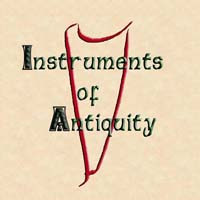
create for you?
(Links lead to detailed pages with larger photos and more information...)
Authentic:
Citole:
Cantigas style
Warwick style
Drums:
Bodhran
Gusli
Harps:
Bardic/Lap Harps:
Gut Strung
Celtic Wire Strung
Floor Harps:
Gothic
(more to come)
Kantele:
5 string
5 string Piccolo
9 string
Performance set
Lyres:
Trossingen
Sutton Hoo
Mosning Thorpe
Bergh Apton
Oberflacht
Cologne
Student Model
Bowed Lyres:
Crwth
Jouhikko
Psaltries:
Pig Nose
Cantigas style
Rebecs:
Soprano
Alto
Tenor
Bass
Zithers:
Fretted:
Epignette
Scheitholt
Fretless:
Myrna Hammered Dulcimer
Echoic:
Non-authentic,
but imitative of
the sound of the original instrument
Flutes
Whistles
11th Century
3-String Crwth (Crwth Trithant)

The first bowed instrument native to Western Europe, the Welsh Crwth - pronounced crooth, like tooth - (Crowd, in England; Cruit, in Ireland) was an adaptation of the traditional plucked or strummed lyre with the addition of a fingerboard. The earliest instruments had only 3 strings. The bridge remained flat and the instrument was tuned in the intervals of a 4th and a fifth, so that when all strings were bowed together harmonies were generated around either a tonic or a 7th chord. very little is known about this instrument in this form, although it did survive and develop into the folk crwth of today, with 6 strings tuned similarly but in octave pairs.
Interestingly, the Crwth is the only instrument in which one foot of the bridge extends through the soundhole on the soundboard and rests on the back of hte instrument. A prevailing theory is that the instrument, being as wide as it was and with no bracing on the soundboard, needed to have the string tension distributed between the front and the back in order to keep from breaking the soundboard. A fortunate side effect of that design is that each surface that the bridge feet touch act as an individual soundboard, and thus the instrument projects in an amazing way, with much more volume and power than you would expect.
This example is gut strung, with black walnut for the body, red spruce for the soundboard, and Brazillian cherry for the fingerboard and tailpiece. It can be built in various scale lengths, and with many wood choices, finish choices, string and ornament options, just contact us to discuss your desires and we can familiarize you completely with the options available to make it real.
For
more information or to place an order, contact:
Chris Nogy,
founder and craftsmancontact@instrumentsofantiquity.com
Phone: 479-283-6364
Please call between 9 AM and 7 PM U.S. Central Time (-6 GMT)
copyright (c) 2011